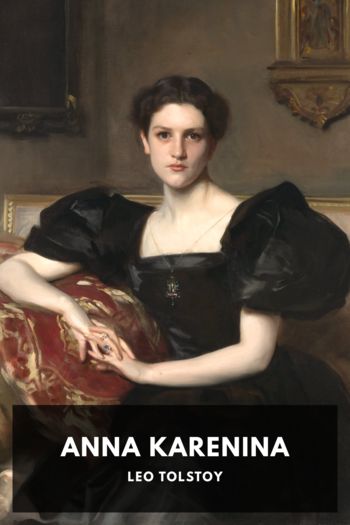What Is Art? Leo Tolstoy (good books to read for 12 year olds TXT) 📖

- Author: Leo Tolstoy
Book online «What Is Art? Leo Tolstoy (good books to read for 12 year olds TXT) 📖». Author Leo Tolstoy
According to Adam Müller (1779–1829), there are two kinds of beauty; the one, general beauty, which attracts people as the sun attracts the planet—this is found chiefly in antique art—and the other, individual beauty, which results from the observer himself becoming a sun attracting beauty—this is the beauty of modern art. A world in which all contradictions are harmonised is the highest beauty. Every work of art is a reproduction of this universal harmony.27 The highest art is the art of life.28
Next after Fichte and his followers came a contemporary of his, the philosopher Schelling (1775–1854), who has had a great influence on the aesthetic conceptions of our times. According to Schelling’s philosophy, art is the production or result of that conception of things by which the subject becomes its own object, or the object its own subject. Beauty is the perception of the infinite in the finite. And the chief characteristic of works of art is unconscious infinity. Art is the uniting of the subjective with the objective, of nature with reason, of the unconscious with the conscious, and therefore art is the highest means of knowledge. Beauty is the contemplation of things in themselves as they exist in the prototype (In den Urbildern). It is not the artist who by his knowledge or skill produces the beautiful, but the idea of beauty in him itself produces it.29
Of Schelling’s followers the most noticeable was Solger (1780–1819—Vorlesungen über Aesthetik). According to him, the idea of beauty is the fundamental idea of everything. In the world we see only distortions of the fundamental idea, but art, by imagination, may lift itself to the height of this idea. Art is therefore akin to creation.30
According to another follower of Schelling, Krause (1781–1832), true, positive beauty is the manifestation of the Idea in an individual form; art is the actualisation of the beauty existing in the sphere of man’s free spirit. The highest stage of art is the art of life, which directs its activity towards the adornment of life so that it may be a beautiful abode for a beautiful man.31
After Schelling and his followers came the new aesthetic doctrine of Hegel, which is held to this day, consciously by many, but by the majority unconsciously. This teaching is not only no clearer or better defined than the preceding ones, but is, if possible, even more cloudy and mystical.
According to Hegel (1770–1831), God manifests himself in nature and in art in the form of beauty. God expresses himself in two ways: in the object and in the subject, in nature and in spirit. Beauty is the shining of the Idea through matter. Only the soul, and what pertains to it, is truly beautiful; and therefore the beauty of nature is only the reflection of the natural beauty of the spirit—the beautiful has only a spiritual content. But the spiritual must appear in sensuous form. The sensuous manifestation of spirit is only appearance (schein), and this appearance is the only reality of the beautiful. Art is thus the production of this appearance of the Idea, and is a means, together with religion and philosophy, of bringing to consciousness and of expressing the deepest problems of humanity and the highest truths of the spirit.
Truth and beauty, according to Hegel, are one and the same thing; the difference being only that truth is the Idea itself as it exists in itself, and is thinkable. The Idea, manifested externally, becomes to the apprehension not only true but beautiful. The beautiful is the manifestation of the Idea.32
Following Hegel came his many adherents, Weisse, Arnold Ruge, Rosenkrantz, Theodor Vischer and others.
According to Weisse (1801–1867), art is the introduction (Einbildung) of the absolute spiritual reality of beauty into external, dead, indifferent matter, the perception of which latter apart from the beauty brought into it presents the negation of all existence in itself (Negation alles Fürsichseins).
In the idea of truth, Weisse explains, lies a contradiction between the subjective and the objective sides of knowledge, in that an individual I discerns the Universal. This contradiction can be removed by a conception that should unite into one the universal and the individual, which fall asunder in our conceptions of truth. Such a conception would be reconciled (aufgehoben) truth. Beauty is such a reconciled truth.33
According to Ruge (1802–1880), a strict follower of Hegel, beauty is the Idea expressing itself. The spirit, contemplating itself, either finds itself expressed completely, and then that full expression of itself is beauty; or incompletely, and then it feels the need to alter this imperfect expression of itself, and becomes creative art.34
According to Vischer (1807–1887), beauty is the Idea in the form of a finite phenomenon. The Idea itself is not indivisible, but forms a system of ideas, which may be represented by ascending and descending lines. The higher the idea the more beauty it contains; but even the lowest contains beauty, because it forms an essential link of the system. The highest form of the Idea is personality, and therefore the highest art is that which has for its subject-matter the highest personality.35
Such were the theories of the German aestheticians in the Hegelian direction, but they did not monopolise aesthetic dissertations. In Germany, side by side and simultaneously with the Hegelian theories, there appeared theories of beauty not only independent of Hegel’s position (that beauty is the manifestation





Comments (0)